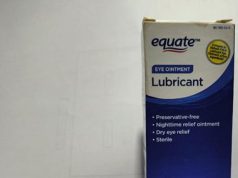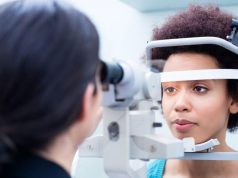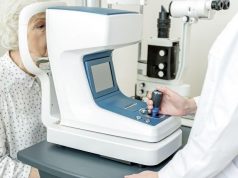By Beth Gilbert HealthDay Reporter
The annual meeting of the American Academy of Ophthalmology was held from Nov. 3 to 5 in San Francisco and attracted participants from around the world, including ophthalmologists, optometrists, opticians, and other eye health care professionals. The conference featured presentations focusing on the latest advances in comprehensive eye care, including medical, surgical, and optical care.
In the phase 3 Childhood Atropine for Myopia Progression clinical study, Darren J. Bell, M.D., of Medical Center Ophthalmology Associates in San Antonio, and colleagues found that low-dose atropine is effective for all children with myopia, irrespective of age, sex, race, iris color, or baseline spherical equivalent refraction.
The authors randomly assigned children with myopia and between â0.50 D to â6.00 D spherical equivalent refraction to a proprietary formulation of low-dose atropine or placebo. The researchers found that nightly dosing with NVK002 0.01 percent, a novel, preservative-free atropine eye drop formulation, significantly increased the proportion of myopic children in the United States and Europe aged 3 to 17 years who progressed <0.50 D in myopia over three years. Analysis of the proportion of children who progressed less than 0.75 D (prespecified) and 1.00 D (post hoc) over three years demonstrated similarly meaningful reduction in myopia progression at those clinically relevant thresholds.
“Over three years, in myopic children, once-nightly NVK002 0.01 percent eye drops meaningfully slowed myopia progression at 0.50 D, 0.75 D, and 1.00 D thresholds,” Bell said. “This may reduce the longer-term progression of myopia, leading to less frequent changes in spectacle correction and potentially reducing the long-term risk of myopia complications such as retinal detachment and glaucoma.”
One author disclosed financial ties to the pharmaceutical and biotechnology industries.
In a retrospective case series, Zeeshan Haq, M.D., of Retina Consultants of Minnesota in Minneapolis, and colleagues found that most patients with predominantly no or minimal diabetic retinopathy have no worsening in their disease status after initiation of semaglutide.
Using data from the Intelligent Research in Sight® Registry, the authors performed a retrospective case series that included patients with type 2 diabetes mellitus for whom nonoral semaglutide was initiated with at least three months of follow-up. The number of eyes included in the study was 96,432, of which 71.8 percent had either no or background diabetic retinopathy. The researchers found that the proportion of patients who experienced a worsening of their diabetic retinopathy status was low (1.3 to 2.2 percent) at all studied time points (three, six, 12, and 24 months).
“Additional research on this topic is necessary. In particular, the impact of semaglutide initiation on short- and long-term outcomes in potentially high-risk patients, such as those with severe nonproliferative or proliferative diabetic retinopathy, should be investigated,” Haq said. “Having said that, physicians can inform diabetic patients with no or minimal diabetic retinopathy that their risk of experiencing a worsening in their diabetic eye disease is low after initiation of semaglutide. Nonetheless, eye care providers should be vigilant and monitor these patients more closely until additional data are available.”
In a retrospective review, Mary Ellen Hoehn, M.D., of the University of Tennessee Health Science Center in Memphis, and colleagues found that children with sickle cell disease likely need to be screened for retinopathy as often as adults with the condition.
The authors evaluated data for 652 patients, aged 10 to 25 years (median age, 14) who underwent eye exams (2,240 visits) over a one-year period. The researchers found that approximately 33 percent of those 25 and under had retinopathy, 9 percent of whom required treatment. Specifically, 33 percent had nonproliferative retinopathy and 6 percent had proliferative retinopathy (PR). In addition, 33 eyes were treated with panretinal photocoagulation, most commonly for PR stage 3 (43 percent), and intravitreal anti-vascular endothelial growth factor therapy was administered to five eyes with PR. Other complications also occurred, including retinal detachment, retinal artery occlusion, and vision loss.
“We hope that people will use this information to better care for patients with sickle cell disease, and that more timely ophthalmic screen exams will be performed so that vision-threatening complications from this disease are prevented,” Hoehn said in a statement.
AAO: Diabetic Retinopathy Usually No Worse With Semaglutide in T2D
THURSDAY, Nov. 9, 2023 (HealthDay News) — For patients with type 2 diabetes mellitus, most eyes have no worsening of diabetic retinopathy after initiation of semaglutide, according to a study presented at the annual meeting of the American Academy of Ophthalmology, held from Nov. 3 to 6 in San Francisco.
AAO: Research Highlights Vision Issues Seen in Pediatric Sickle Cell Disease
THURSDAY, Nov. 9, 2023 (HealthDay News) — For pediatric patients with sickle cell disease, ophthalmologic complications include nonproliferative retinopathy and proliferative retinopathy, which occur in 33 and 6 percent, respectively, according to a study presented at the annual meeting of the American Academy of Ophthalmology, held from Nov. 3 to 6 in San Francisco.
Copyright © 2023 HealthDay. All rights reserved.








